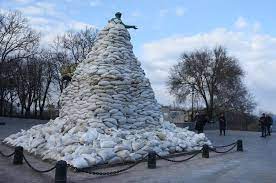Ontario, July 11: During the Russian invasion of Ukraine, the possibility of a cyberwar has been a constant threat. The consequences of a breach extend far beyond a threat to national security. They extend and threaten cultural and artistic production — galleries, libraries, archives, museums and universities must be protected.
The invasion of Ukraine has been a hybrid war fought with traditional kinetic weapons alongside cyberattacks. The prelude to the war included widespread attacks on Ukrainian organisations.
While there were early reports about the underwhelming performance of Russia’s fabled cyber capabilities, the brutal reality of war does not easily match the precise planning required to stage a cyberattack.
AUkrainian archivists, curators and librarians have been protecting both material and digital archives throughout the war. Monuments, like the statue of Duke de Richelieu in Odesa, were piled high with sandbags. And an international coalition of archivists is taking on the less visible work to protect collections in institutions and libraries.
Because digitising is a key aspect of this preservation work, it is time to consider protecting digital infrastructure alongside economic, industrial and military targets.
Putin’s rambling speech, just days before the invasion on February 24, claims Ukraine as “an inalienable part of [Russia’s] own history, culture and spiritual space.” The attempted nullification of Ukrainian culture is both a pretext for invasion as well as a military objective.
Ihor Poshyvailo, the general director of the Maidan Museum in Kyiv, called on the global community to combat Putin’s “pseudohistory.”
This is not Poshyvailo’s first time preserving history. In 2013, he was involved in preserving the history of the 2013 Euromaidan movement — otherwise known as the Revolution of Dignity — that overthrew the pro-Putin Viktor Yanukovych regime.
In a tweet marking the first month of Russia’s invasion, Poshyvailo described how history and language are tightly connected to identity:
It’s easy to imagine how a museum director might work quietly collecting and preserving the artifacts that trace the history of significant things, people and events. In Ukraine, any material evidence of this democratic revolution is a threat to Putin’s autocratic rule as he remains intent on bending reality to match his limited view of history.
When the pretext for war is cultural non-existence, history and language become targets. As a genocidal and colonial project, the erasure of the past is a prerequisite for social control.
Cultural conservation in a time of war is an heroic act. An emergency response is currently underway in the Maidan Museum to rapidly protect artifacts by moving them out of harm’s way.
The emergency rescue of cultural heritage should be a feature of all conflicts, as previous incidents have shown. The destruction of Afghanistan’s Buddhas of Bamiyan in 2001, the looting of Baghdad’s National Museum of Iraq in 2003 or the 2015 demolition of the Temple of Bel in Palmyra, Syria are reminders of what we risk.
Digitization of cultural artifacts offers some promise of protection. But servers are, after all, just computers, and computers are fragile: they are constantly in need of electricity, network connections and maintenance to remain functioning. Computers are also vulnerable to cyberattacks.
In a 2020 Microsoft Digital Defense Report, higher education ranked in the top six targeted industry sectors. Universities manage large networks that attract criminals interested in running ransomware scams or cryptojacking (using a network without permission to mine cryptocurrency).
Research institutions are also targeted by governments interested in high-value data like student personal and financial data. And universities often host online archives of cultural research and memory.
Supporting digital infrastructure for the collection and preservation of cultural history also means protecting these systems. Amazon Web Services won an award from President Volodymyr Zelenskyy for preserving governmental digital infrastructure, but cultural organizations also need special protection. Data integrity is about more than long—term storage — it is also about developing plans for data recovery and mitigation in the event of a cyberattack.
Social media can be used to amplify attention toward collections and their preservation. However, this may place cultural workers and their institutions at greater risk from hostile forces.
There have been other irritants to Russia’s cyberwar efforts, including the volunteer Ukrainian IT Army. This international collection of cybersecurity professionals donates its time and expertise to defend and harass Russia’s ability to fight a cyberwar.
Operating in any conflict-affected area requires training.
Another volunteer army of digital archivists is working to collect digital exhibits and website data from over 1,500 Ukrainian museums and libraries. Saving Ukrainian Cultural Heritage Online collected public data from thousands of websites. Under the supervision of professional librarians and archivists, the project team saved hundreds of sites from potential loss.
In the future, digital archivists will need support from the broader security community to secure their operations and safely work in hazardous online environments. For now, it’s unclear if these archives focused on cultural preservation will be used. Maybe these backups will never be needed. Or maybe they will represent a snapshot of Ukraine’s history in a moment of crisis. (AP)
Home International Ukrainian cultural artifacts are at risk during the Russian invasion, but digitizing...


